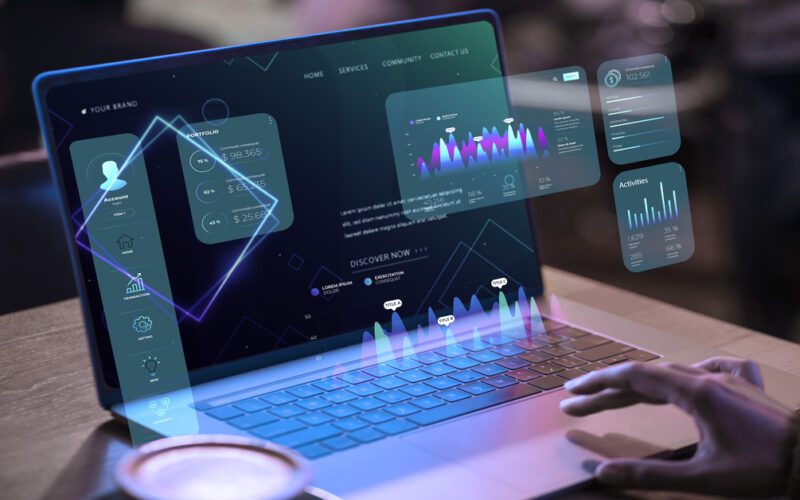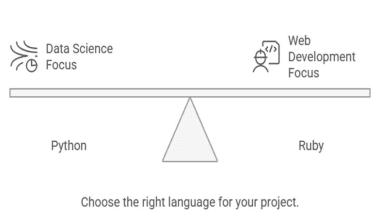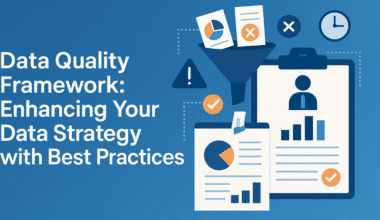Summary: Data Science involves analysing large datasets to derive insights and make informed decisions using Machine Learning and predictive analytics. Understanding customer behaviour, predicting trends, and making strategic decisions are essential for businesses to stay competitive.
Introduction
The demand for data storehouses increased as the globe transitioned into the extensive data period. Until 2010, it was the primary issue and source of concern for businesses. Thus, creating a frame and data storehouse results was the main focus.
Now that Hadoop and other fabrics have effectively answered the storehouse issue, the focus has changed to processing this data. The crucial component in this is data wisdom. Data wisdom can make all the generalities you see in Hollywood sci-fi pictures a reality.
The future of Artificial Intelligence lies in data wisdom. Thus, it’s pivotal to comprehend what data wisdom is and how it may profit your company.
What is Data Science?
Data Scientists use sophisticated ways and tools to dissect vast data to find retired patterns, gather necessary knowledge, and make business opinions. Data wisdom uses sophisticated Machine Learning ways to make vaticination models.
Applying prophetic unproductive analytics can help you produce a model that can prevent liability for a specific circumstance in the future. For illustration, if you’re an advancing plutocrats, you might be concerned about your guests’ propensity to make their unborn credit payments on schedule.
Then, you may produce a model that uses prophetic analytics to determine if unborn payments from the client will be entered on time or not grounded on their payment history.
Conventional analytics are necessary if you want a model with the intelligence to make its own opinions and the capacity to change using dynamic parameters. In this comparatively new discipline, guidance is everything. In other words, it not only vaticinates but also hints at various advised conduct and their matching results.
Google’s tone-driving auto, which I also preliminarily stressed, is a stylish illustration of this. Tone-driving motorcars can be trained using data gathered from moving objects, and algorithms can be run on this data to add intelligence.
Thanks to this, your machine will be suitable for making judgments like when to turn, which route to take, and whether to decelerate down or accelerate.
Machine Learning for Prognosticating
Machine Learning algorithms are your stylish bet if you have transactional data from a fiscal institution and must produce a model to anticipate the unborn trend. It fits under the supervised learning paradigm.
It is known as supervised learning because you formerly had data on which to train your machines. For instance, you can train a fraud detection model using past data on fraudulent purchases.
Machine Learning for Pattern Discovery
To produce prognostications that have any value when there are no parameters to predicate them, it’s necessary to uncover any retired patterns that may live in the dataset.
Considering that there are no specified markers for grouping, this is nothing further than the unsupervised model. Clustering is the most habituated approach for changing patterns.
Imagine you work for a telephone company and have to create a network by placing halls in a specific area. The clustering system can also identify the palace locales, guaranteeing that all guests admit the strongest signal possible.
Data Science: Why Is It Important?
Data wisdom, AI, and Machine Learning are increasingly crucial to businesses. Regardless of their size or assiduity, companies must quickly produce and implement data wisdom capabilities to be competitive in the big data period. Otherwise, they need to catch up.
Why Data Science?
Historically, we had largely bitsy, systematised data sets that analysts with straightforward BI tools could examine. Generally, moment’s data lacks shape or is semi-structured, unlike the data in traditionally used systems, which was primarily structured.
Let’s examine the operations of data wisdom in further detail. What if you could determine your guests’ exact requirements from the available information, similar to their once browsing and copping patterns, age, and income?
You had access to all this information in history. Still, given the volume and diversity of data available now, you’re better suited to train models and make accurate product recommendations to your guests. Wouldn’t it be awful if it increased business for your company?
Let’s look at a different illustration to grasp how data wisdom influences opinions. What if your auto was smart enough to take you home?
To make a chart of their surroundings, tone-driving buses gather real-time data from detectors similar to radars, cameras, and spotlights. Based on this data, they use sophisticated Machine Learning algorithms to decide when to speed up, when to decelerate down, when to catch, and where to turn.
Who’s A Data Scientist?
There are several definitions used to describe Data Scientists. Simply defined, a Data Scientist works within the field of Data Science. After it became clear that a Knowledge Scientist would significantly rely on mathematical and statistical applications and other scientific fields and applications, researchers developed the term “Data Scientist.”
Read More: Cheat Sheets for Data Scientists – A Comprehensive Guide.
What Is The Role Of A Data Scientist?
Data Scientists are experts in various scientific fields who can solve data challenges. They utilise multiple concepts from arithmetic, statistics, computing and other essential topics. However, one must note that a Data Scientist might not excel in all these fields.
They often use the most recent technologies to solve problems and make decisions essential to an organisation’s expansion and development. Compared to the data they can get from organised and unstructured formats, Data Scientists provide it in a much more useful format.
More to See: How can Data Scientists use ChatGPT to develop Machine Learning Models?
Which Data Science Position Does One Fit?
You can focus on and hone your skills in a single area of Data Science to make valuable contributions to this rapidly evolving field.
You can develop deep expertise, drive innovation, and become a go-to expert in your chosen domain within the Data Science industry by specialising. Here are some ways to contribute to this intriguing, quickly developing business.
Data Scientist
Data Scientists identify problem characteristics, issues to solve, and relevant data locations. They collect, clean, and present essential data. Critical skills include understanding Hadoop, SQL, Machine Learning, storytelling, data visualisation, and programming in SAS, R, and Python. Data Scientists bridge the gap between business analysts and Data Scientists, providing actionable insights.
Data Scientists require proficiency in statistics, mathematics, and programming and familiarity with data processing and visualisation. They convert technical assessments into actionable courses of action. On the other hand, data engineers create, implement, maintain, and improve the organisation’s data infrastructure and pipelines, ensuring seamless data flow and analysis.
Lifecycle of Knowledge Science
The knowledge science life cycle is a crucial framework that guides the systematic development, deployment, and maintenance of Data Science projects. Understanding the critical phases is essential for producing accurate, effective, and impactful data-driven solutions.
Mastering the life cycle ensures that Data Science projects structure well, iterate effectively, and align with business objectives. This knowledge empowers Data Scientists to deliver maximum value through their work. The following list summarises the critical stages of the knowledge science lifecycle.
Phase 1: Discovery
Before you begin the project, it is essential to understand the numerous requirements, priorities, and budgets that are necessary. The skill to ask the right questions is critical. Here, you identify whether you have the essential personnel, technology, time, and data to support the project. You also want to frame the business challenge and create Initial Hypotheses (IH) to test at this phase.
Phase 2: Data Preparation
During this phase, you will need an analytical sandbox where you may run analyses throughout the project. Before modelling, you want to investigate, prepare, and condition the information. You’ll also perform ETLT (Extract, Transform, Load, and Transform) to urge data into the sandbox. Take a glance at the flowchart for the statistical analysis below.
Preparing the analytics Sandbox – Performing ETLT – Data Conditioning – Survey and visualise
R is often used for data transformation, cleansing, and visualisation. You’ll use this to identify outliers and establish a connection between the variables. After you’ve cleaned and prepped the data, it is time to perform exploratory analytics on it. Let’s examine how you can accomplish that.
Phase 3: Planning Models For Data Science
In this phase, you’ll decide how to depict the relationships between the variables in this section. These connections will be the framework for your algorithms in the following stage. You’ll use several statistical methods and visualisation tools to apply Exploratory Data Analytics (EDA).
Phase 4: Model Construction
During this stage, you’ll create datasets for both training and testing. You must decide whether the models can run using your current tools or if a more stable environment (like fast and parallel processing) is required. To develop the model, you’ll examine various learning strategies, including classification, association, and clustering.
Phase 5: Operationalise Data Science
In the fifth phase. Delivering final reports, briefings, code, and technical papers fall into this phase. Data analysts may occasionally deploy a pilot program in a real-time production setting. Before complete deployment, this may give you a good image of the performance and other related limits on a modest scale.
Phase 6: Communicate findings
Now, assessing whether you successfully achieved the objective you set for yourself in the previous phase is essential. Therefore, within the final phase, you identify the many findings, inform the stakeholders, and choose whether the project’s outcomes are successful or unsuccessful using the criteria created in Phase 1.
Data Science Tools
Data Scientists employ popular programming languages for statistical regression and exploratory data analysis. These open-source tools include pre-built Machine Learning, graphics, and statistical modelling capabilities. you’ll learn more about these languages in “Python vs. R: what is the Difference?”
Python and R
Python and R are two of the most famous programming languages required in Data Science. These two languages are often misunderstood to be the same. However, there are significant differences between the two. The following are some of the differences between Python and R:
R: A free, open-source environment and programming language for creating statistical computing and visuals.
Python: This programming language is dynamic and adaptable. Python offers several libraries, similar to NumPy, Pandas, and Matplotlib, for assaying data snappily.
Enhancing Accessibility with GitHub and Jupyter
Data Scientists rely on collaborative platforms such as GitHub and Jupyter to streamline sharing and teamwork in data analysis. These platforms provide user-friendly interfaces and robust tools for documenting and disseminating code, enhancing collaboration accessibility.
By leveraging these platforms, Data Scientists can seamlessly collaborate on projects, track changes, and maintain version control, fostering a more efficient and transparent workflow. This accessibility empowers teams to collaborate effectively regardless of geographical location, ensuring that insights are shared, refined, and applied efficiently across the organisation.
Enterprise Tools for Statistical Analysis
In addition to open-source languages, enterprise-level tools such as SAS and IBM SPSS offer a comprehensive suite of features tailored to meet the complex demands of professional Data Scientists and Analysts operating within enterprise environments. These tools go beyond fundamental statistical analysis, providing advanced predictive modelling, data mining, and text analysis capabilities.
Moreover, they empower users to create interactive dashboards and visually compelling representations of data, facilitating informed decision-making processes. With robust support and extensive documentation, SAS and IBM SPSS are pillars in the arsenal of tools for data-driven insights within the corporate landscape.
Big Data Processing Platforms
As the volume of data expands exponentially, Data Scientists must be adept at managing vast datasets efficiently. Apache Spark and Apache Hadoop are pivotal platforms that enable distributed processing, facilitating the analysis of massive datasets in parallel. Their scalability and fault tolerance make them indispensable for handling Big Data challenges.
Additionally, NoSQL databases offer flexible data storage solutions, accommodating diverse data types and structures. Mastery of these platforms is imperative for modern Data Scientists, empowering them to derive actionable insights from the deluge of data encountered in contemporary data-driven applications.
Data Visualisation Tools
Effective data visualisation is crucial for conveying complex insights to stakeholders in an easy-to-understand manner. Data Scientists employ a diverse toolkit, leveraging open-source libraries such as D3.js for customisable and interactive visualisations.
Additionally, commercial platforms like Tableau and IBM Cognos offer user-friendly interfaces and advanced features, enabling the creation of dynamic and insightful visualisations. These tools empower Data Scientists to present findings intuitively, facilitating informed decision-making and driving actionable outcomes within organisations.
Machine Learning Libraries
Machine Learning forms the backbone of numerous data-driven applications, driving innovation across industries. Data Scientists heavily depend on powerful libraries such as PyTorch, TensorFlow, MXNet, and Spark MLlib to develop and implement intricate machine learning models.
These libraries provide an extensive suite of algorithms and tools, facilitating the training, fine-tuning, and evaluating models to ensure optimal performance and accuracy. Whether deep learning with PyTorch and TensorFlow or distributed computing with Spark MLlib, these versatile frameworks empower Data Scientists to harness the full potential of machine learning for solving complex real-world problems.
Additionally, Data Scientists use Microsoft Excel to perform spreadsheet operations.
The Emergence of Multi-Person DSML Platforms
Organisations are increasingly adopting Multi-Person Data Science and Machine Learning (DSML) platforms to democratise data science and enhance ROI on AI systems. These platforms integrate automation, intuitive interfaces, and robust collaboration tools, enabling a diverse range of users, from novices to seasoned experts, to derive actionable insights from data efficiently.
These platforms foster collaboration and knowledge sharing, empowering teams to leverage collective expertise, accelerating innovation and driving tangible business outcomes.
The concept of “citizen Data Scientists” is gaining traction as organisations seek to bridge the gap between data expertise and business needs. Multi-person DSML platforms enable individuals with varying technical knowledge to contribute to data-driven initiatives, fostering enterprise-wide collaboration and innovation.
Data Wisdom Operations Include
Data wisdom operations involve transforming raw data into actionable insights through structured and contextualised analysis. This process enables organisations to make informed decisions by leveraging data to create knowledge and wisdom. It involves digitisation, digitalisation, and digital transformation to unlock the full potential of data. Let’s see what data wisdom operations include:
Search Machines
Data wisdom is most beneficial in hunting machines. As is common knowledge, with the maturity of the times, we have used hunt machines like Google, Yahoo, Safari, Firefox, and others to find effects online. Data wisdom is, therefore, employed to speed up quests.
For example, if we search for “Data Structures and Algorithm Courses”, the first link on Internet Discoverer is for GeeksforGeeks Courses. This occurs because most people visit the GeeksforGeeks website to learn about data structure courses and other computer-related topics. This inquiry exercises data wisdom, attaining the top-visited web links.
Transport Assiduity
Like driverless buses, data wisdom has entered the transport industry. Driverless buses can fluently lower accident rates. Data Science approaches examine the training data fed to the algorithms of driverless buses to determine the speed limit on roadways, busy thoroughfares, and narrow roads, and respond to various driving circumstances.
In Finance
Data wisdom has a significant impact on fiscal diligence. Budgetary diligence always faces fraud and the threat of losses. Financial diligence must automate threat of loss analysis to make strategic opinions for the association. Fiscal diligence also uses data wisdom analytics to read the future. It enables businesses to read stock request movements and customer continuance value.
Data wisdom, for example, is pivotal in the stock request. In the stock request, Data Scientists use literal data to dissect one gestation with the goal of soothsaying future results. The analysis of data allows for the vaticination of unborn stock values.
In E-commerce
Websites like Amazon, Flipkart, and others use e-commerce data wisdom to improve client experience with customised recommendations.
For example, when we search for anything on e-commerce websites, we accept recommendations grounded on choices similar to those grounded on our literal data and recommendations grounded on the most popular products, conditions, quests, etc. Data wisdom aids in fulfilling all of this.
In Healthcare
Data wisdom has revolutionised the healthcare sector by enabling the discovery of medicines, image analysis in drug development, and virtual healthcare robots. It has also improved diagnostic predictive modelling, allowing for more accurate diagnoses and personalised treatments. It has significantly enhanced patient care and outcomes.
Data wisdom has also been instrumental in the discovery of new medicines and treatments. Researchers have used data wisdom to identify potential tumour biomarkers and develop targeted therapies. Additionally, it has enabled the analysis of genetic and genomic data to better understand the underlying causes of diseases, leading to more effective treatments and improved patient outcomes.
Image Identification
Presently, image recognition also makes use of data wisdom. For case, when we submit an image of our friend on Facebook, Facebook suggests tagging other people in the image. Machine Learning and Data Science help accomplish it. Data is analysed from one’s Facebook musketeers when recognizing an image. If the faces in the image correspond to someone different’s profile after analysis, Facebook proposes bus trailing.
Recommendation for Targeting
Data wisdom’s most significant operation is targeting recommendations. The stoner will find several posts anywhere they look on the Internet. The following illustration will help you understand this. Let’s say I want a phone and Google it, but I also decided I’d instead buy one offline.
Companies that invest in mobile advertising benefit from data wisdom. I’ll thus see recommendations for the mobile phone I was looking for far and wide on the Internet, including social media, websites, and apps. It will impel me to make purchases online. Planning of airline routes.
The airline industry is expanding due to data wisdom since it makes it simple to predict flight delays. Also, deciding whether to fly directly from one position to another or to make a stop in between might be helpful. For illustration, a trip from Delhi to the United States may be direct or may make a stop before arriving at its destination.
Gaming Area
Game developers employ data wisdom principles alongside machine learning in maturing games where players compete against computer opponents. The use of literal data enhances the computer’s performance. Multitudinous games are available, including EA Sports and Chess.
Medicine And Medical Development
Making drugs is a largely gruelling, drawn-out procedure that requires extreme discipline because someone’s life is at stake. Creating new drugs or medicines without data wisdom involves time, plutocrats, and coffers. Still, with data wisdom, the vaticination of success rates may be snappy.
The estimate is based on natural data or characteristics. The data wisdom-grounded algorithms will only prognosticate how this will respond to the mortal body if it conducts laboratory tests.
Speech addition
Data wisdom methods predominate in speech recognition. The excellent work of these algorithms may be apparent in our diurnal conditioning. Have you ever required a virtual speech adjunct like Siri, Alexa, or Google Assistant?
Their voice recognition technology works in the background to try to understand and assess your words and give you precious information grounded in your use. Image recognition is also possible on social networking sites like Facebook, Instagram, and Twitter. These programs will identify and tag people on our list when you upload a print of yourself with them.
Individualised Marketing
If you believe that Hunt was the most pivotal use of data wisdom, consider the full range of digital marketing. Data wisdom algorithms promote nearly everything, from display banners on colourful websites to digital billboards at airfields.
It explains why traditional marketing has a far lower CTR(Call-through rate) than digital advertising. Data professionals can customise them based on a stoner’s former geste. It explains why you can see advertisements for data wisdom training programs while someone differently in the same area is seeing advertisements for vesture.
Stoked reality
Last but not least, the final operations of data wisdom feel the most pledge for the future. Yes, we are talking about something other than stoked reality right now. Do you realise that data wisdom and virtual reality have an intriguing relationship?
For the stylish viewing experience, a virtual reality headset combines data, algorithms, and calculating knowledge. Pokemon GO, a well-known game, is a little step in that direction—the freedom to explore and catch Pokemon on structures, roads, and other imaginary shells.
You are exercising information from Ingress, the company’s former app. The inventors of this game named the locales of the Pokemon and gymnasiums.
What are the Prerequisites for Data Science?
Data Scientists turn data into helpful perceptivity about everything from goods development to client retention to new business openings by using their moxie in statistics and modelling. To enrol in a Data Science course, you must have at least a bachelor’s degree.
If you’re interested in a career in data science, you should first realize that you must have expansive exposure to mathematics and computer programming. Also, a seeker must be proficient in statistics to enter the field of data wisdom. Still, in general, you must retain the following skill set:
- Math and direct algebra are the most acceptable ways of modelling abecedarian.
- Retrogression, probability distributions, and statistical significance are essential generalities in statistics.
- Python and R are two programming languages.
What Do Data Scientists Do?
You know what data wisdom is, and you must be asking what exactly this job functions like- then the answer is. A Data Scientist examines business data to ripen perceptive conclusions. In other terms, a Data Scientist follows a set of conduct to resolve business issues, similar to:
- The Data Scientist ascertains the issue by raising the applicable queries and gaining an understanding before beginning the data collection and analysis.
- The Data Scientist also chooses the right combination of variables and data sets.
- After gathering the data, the Data Scientist transforms it into a format suitable for analysis and validate the data to ensure uniformity, absoluteness, and delicacy.
- After converting it into a usable form, the data is fed into the logical system—an ML algorithm or a statistical model. At this point, the Data Scientists examine and spot patterns and trends.
- The Data Scientist evaluates the fully rendered data to identify possibilities and results.
- The Data Scientists complete the process by gathering the findings and perceptivity to partake with the applicable parties and conveying the conclusions.
Frequently Asked Questions
What is Data Science?
Data Science involves analysing vast amounts of data using sophisticated techniques and tools to uncover patterns, gain insights, and make informed business decisions. It employs Machine Learning for predictive analytics and decision-making.
Why is Data Science important for businesses?
Data Science is crucial for businesses as it transforms raw data into actionable insights, helping companies predict trends, understand customer behaviour, and make strategic decisions. It enhances competitiveness in the significant data era.
What skills does a person need to become a Data Scientist?
Data Scientists need proficiency in statistics, mathematics, and programming languages like Python and R. They must also possess skills in data processing, visualisation, and machine learning techniques.
Wrapping Up
For the foreseeable future, data will be essential to business operations. Data is practical knowledge that can distinguish between a company’s success and failure. Knowledge is power. By integrating data wisdom tools, businesses can now prognosticate unborn growth, identify implicit issues, and produce successful plans.









